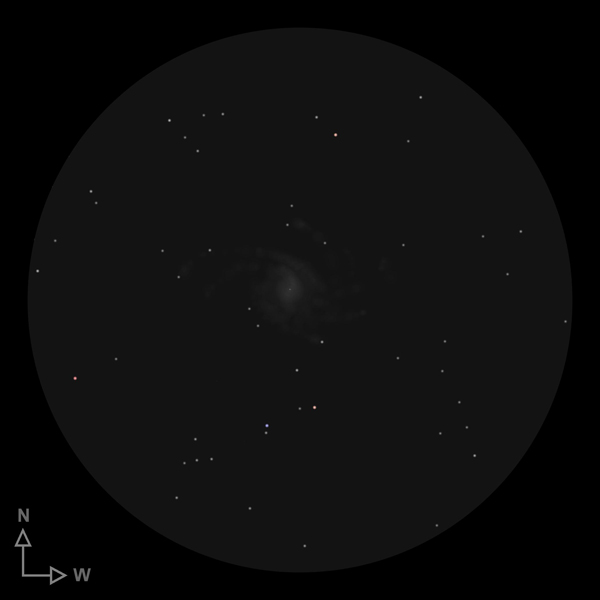
Object Name: NGC 6946 (H.IV.76)
Object Type: Spiral Galaxy
Constellation: Cepheus
Right Ascension (2000.0): 20h 34.8m
Declination (2000.0): +60° 09′
Magnitude: 8.9
Dimensions: 11.5′ x 9.8′
Hubble Class: Sc
Telescope: Parks Astrolight EQ6 • 6″ f/6 Newtonian Reflector
Eyepiece: 7.5mm Parks Gold Series Plössl • 120x, 26′ FoV
Date & Time: 8 September 2007 • 04:15 UT
Seeing Conditions: NELM 6.3 • Pickering 8
Observing Location: Cuyamaca Mts., San Diego Co., California
NGC 6946 is a large face-on spiral galaxy on the Cepheus-Cygnus border. The
constellation boundary runs north-south right through the center of the galaxy.
Most references and guidebooks place NGC 6946 in the constellation Cepheus, but
occasionally it will be listed in Cygnus (as is the case with Luginbuhl & Skiff’s
Observing Handbook and Catalogue of Deep-Sky Objects). This galaxy is notable for
its proximity to open cluster NGC 6939 and the frequency with which it produces
supernovae (eight in the last century). Like several other bright, nearby galaxies,
astronomers once considered NGC 6946 a possible member of the Local Group. It is
now known to be a member of the Coma-Sculptor Cloud and is one of the nearest spiral
galaxies beyond the Local Group at a distance of 15 million light-years.
To locate this low-surface brightness spiral (its light is dimmed by about 1.6
magnitudes by it’s proximity to the plane of the Milky Way), center your scope on
3rd magnitude Eta (η) Cephei and look for the twin glows of NGC 6939 and NGC 6946
about 2° to the southwest. The galaxy is the fainter of the two and lies 38′
southeast of the cluster. At 30x magnification NGC 6946 appears as a subtle glow of
soft gray nebulosity in a rich star field, brighter toward the center with a poorly
defined perimeter.
Increasing the magnification reveals a very faint stellar nucleus embedded in a
moderately bright core, elongated north-south with a little counter-clockwise twist
at each end. Surrounding the core is a slightly elliptical ring of nebulosity,
elongated northeast-southwest, but brighter on the northwest and southeast sides.
Beyond this ring, things start getting a little difficult. Delicate strands of
nebulosity (spiral arm fragments) reveal themselves intermittently with averted
vision.
NGC 6946 was discovered on September 9, 1798 by William Herschel using his 18.7-inch
reflector; he classified it as a planetary nebula.
Eric Graff

Hi Eric,
This is a great sketch. This face on galaxy has a nice core, nucleus and pieces of clean spiral arms. This is what a galaxy like this one really looks like at the eyepiece from a good sky.
Frank